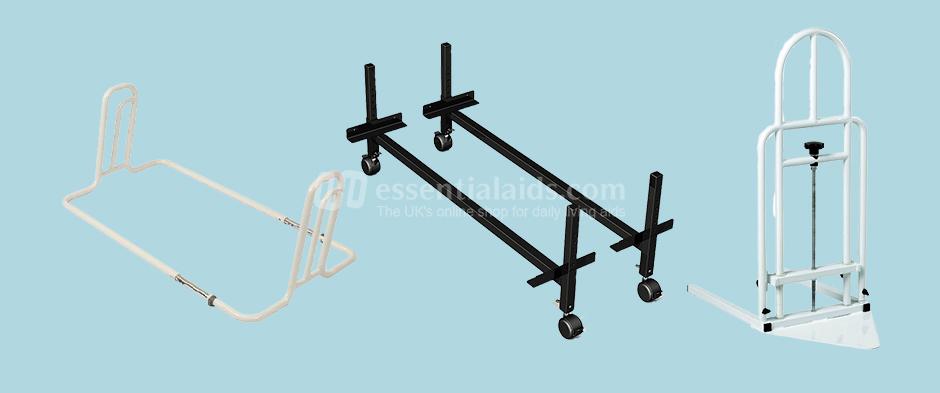
Bedroom Aids - Useful Equipment to Help Get In and Out of Bed
Sally Madeley-Carr, OT22 Jun 2020
If you find yourself with flexibility or strength issues, one of the tasks with which you may have difficulty, is getting in and out of bed. While it's something most healthy people take for granted, this simple action can become a struggle, either because of an injury, a disability or another condition associated with old age.
Fortunately there is an ever-growing list of products available to help the process, most of which are simple to install and use. Aids to help get in and out of bed can become valuable and important tools in your daily routine.
Here, we'll run down some of the most useful.
Bed rails
Bed rails fit either to the bed itself or to the floor next to it, providing a point of support as you either get in or out of bed. Some rails fold or slide down when not in use, keeping them out of the way.
There are numerous designs available from Essential Aids, some of which stretch some way down the length of the bed acting like cot sides, others are shorter, acting more like grab rails.
The latter is a more popular choice if their sole purpose is to assist in getting in or out of bed. While longer rails also assist with this process, often their primary use is to prevent the user accidentally rolling out of bed.
If you're lying horizontally, rails can be used to pull yourself up to a sitting position, before swinging your legs around and perching on the edge of the bed. Once your feet are on the floor, the rail can again be used to provide support as you stand up.
With a single bed, rails on either side allow you to pull yourself up using both at the same time. A rail on just one side may also be helpful, provided you have adequate upper body strength.
It's worth noting the type of fixings this type of rail involves in order to work safely. Many models use the weight of the mattress to hold them in place. With this design, a section of the rail, usually in the shape of two metal poles, slides between the bed itself and the mattress above it.
In some cases, this section is also strapped down to the bed base, ensuring it is as stable as possible. The part of the rail which the user actually holds on to then protrudes upwards, vertical to the side of the bed.
This design tends to be most suitable for divan beds, but it can work on some slatted units too. Other bed rails for slatted beds employ a clamp which fixes to the side of the bed.
The 'Home Bed Rail' is one of the best sellers at Essential Aids. It has the looped section described above under the mattress, plus two vertical 'legs' which stabilize the unit in use.
Other rails require a more substantial fixing, either to the wall or the floor. These offer even more stability and are most suitable in situations for very long term use or where maximum stability is required.
Support rails that attach to the wall
U-shaped 'swing away' rails like those seen next to some toilets are an alternative to standard bed rails. It is possible to fix these to the wall next to the headboard, folding them down when in use and back up again at other times.
The drawback with this design is that the rails need to be fairly long in order to do the job required. This makes them heavy and possibly unduly cumbersome for the purpose.
One increasingly popular option is a floor to ceiling support pole, which again requires permanent fixing. Some versions supply not only a vertical pole, but also a horizontal support rail protruding from it at about waist height.
Shorter rails
The 'U' shape of the fold-down rails is, however, commonly found in bed rails. Rather than mounting so that the curved part of the U is horizontal, versions designed for bed-fixing have it aimed vertically.
The advantage of this shape is that it has no sharp corners or snag points. This means it is less dangerous should the user fall, and it is less likely to snag on clothing or bedding.
As discussed, some of these rails fix by means of strapping or clamps, but smaller, lightweight options use the weight of the mattress to hold them in place.
One such product is the 'Bedside Econorail' from Essential Aids, which provides a U-shaped support point and fits with great ease. It also has built-in pouches to keep items you might need close at hand.
Essential Aids' 'Bed Cane with Organiser' has similar accessible pouches and a 'loop' handle design. In this case the fixing is more substantial, with a flat wood section under the mattress, keeping the rail firmly in place and feeling stable at all times.
The popular 'Bed Rail Advantage Traveller' is another similar rail. In this case it folds up, making it ideal if you need a portable device and you're staying away from home. Again, this model fits by slotting a section between the bed and the mattress.
Supports which hang down over the bed
Another piece of equipment with something in common with the U-shaped rails is the overhead 'Swinging Support' from Essential Aids. It has a similar shape of tubing, and again fixes to the wall. Here the fixing is made above the headboard, in line with the individual's position as they lie on the bed.
The frame extends over them and has a loop of strapping with a handle which hangs down, providing a point from which you can pull yourself up to a sitting position.
Essential Aids' 'Ceiling Support' does a similar job, but in this case the trapeze style support loop attaches to the ceiling itself. In both these cases, as with any fixing to the wall or ceiling, it is vital that the installation is undertaken by a qualified professional.
An alternative device which doesn't require permanent fixing is the 'Patient Helper'. This has the same hanging trapeze support loop, but here it is fitted to a freestanding frame. It has horizontal 'legs', similar to those found on an over bed table, which slide under the bed, allowing positioning of the loop directly over the user.
Bed ladders
A simple device which requires very little installation is the bed 'jacob's ladder'. This is a nylon runged ladder which ties to the foot of the bed, providing the user a means to pull themselves up from a lying to a sitting position.
Although it requires some upper body strength to use effectively, it is a simple solution for those who find the process difficult.
Over bed tables - another aid to consider if you're spending long periods in bed
In hospital environments there are a few extra pieces of equipment which you would not usually find at home. Perhaps the most useful is the over bed table - something with which you will be familiar with from hospital wards. These are essentially tables with the ability to roll in front of the user as they sit up in bed, rolling out of the way when not being used.
Essential Aids supplies a range of overbed tables which are suitable for domestic use, being less bulky and taking up less space than their clinical-setting counterparts.
While many hospital versions tend to have wheels, some domestic ones do not, instead designed with horizontal 'feet' which slide under the bed. This has the advantage of requiring very little clearance room, which is a common problem with divan beds found at home.
It is important to check the clearance measurement beneath your bed to ensure there is adequate room for the over bed table you have in mind. If it does have wheels, their size can vary between models and this detail should be present on the product description or specification details.
Over bed tables with tilting tops are popular choices as they allow newspapers, tablet computers and books to be propped up open without the user needing to hold them. These, like many others, have raised edges around the table tops, preventing items slipping or rolling off.
To accommodate various bed heights, the height of the table will always adjust to fit your needs. This adjustment mechanism depends on the specific table, with simple models having turn-clamps on either side, and more expensive tables using hydraulic or electric power adjustment.
When choosing an over bed table, think about what you will need it for. If it is for reading or similar tasks, you will not need one of the more robust models. If you're going to be eating from the surface, some more substantial might be a better choice.
Some models actually have two separate table tops, like Essential Aids' 'Deluxe Twin Surface Overbed Table'. Here there is one large top, and an additional, smaller one to the side. While the main top can be set at an angle, the small one is fixed horizontally. This makes it useful for cups or mugs if you're using the angled main surface to prop open a book, for example.

Sally Madeley-Carr, OT
Sally qualified as an Occupational Therapist in 1996 and is a well-respected professional in the field of rehabilitation equipment and living aids. She has worked in private practice and within the NHS, developing a broad experience with adults and children. Click here for Sally's registration with the Health and Care Professions Council. The HCPC regulates health, psychological and social work professionals in the UK.